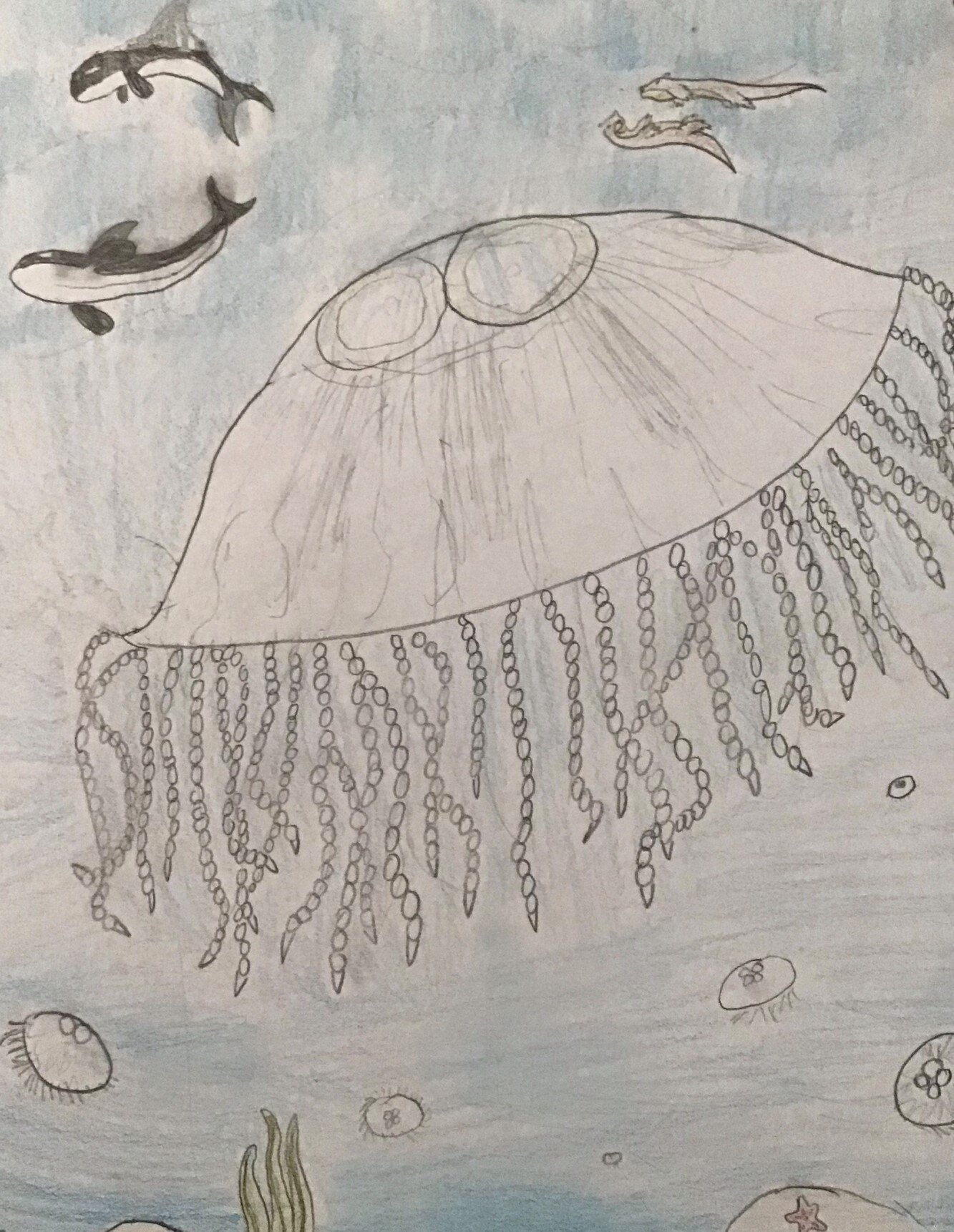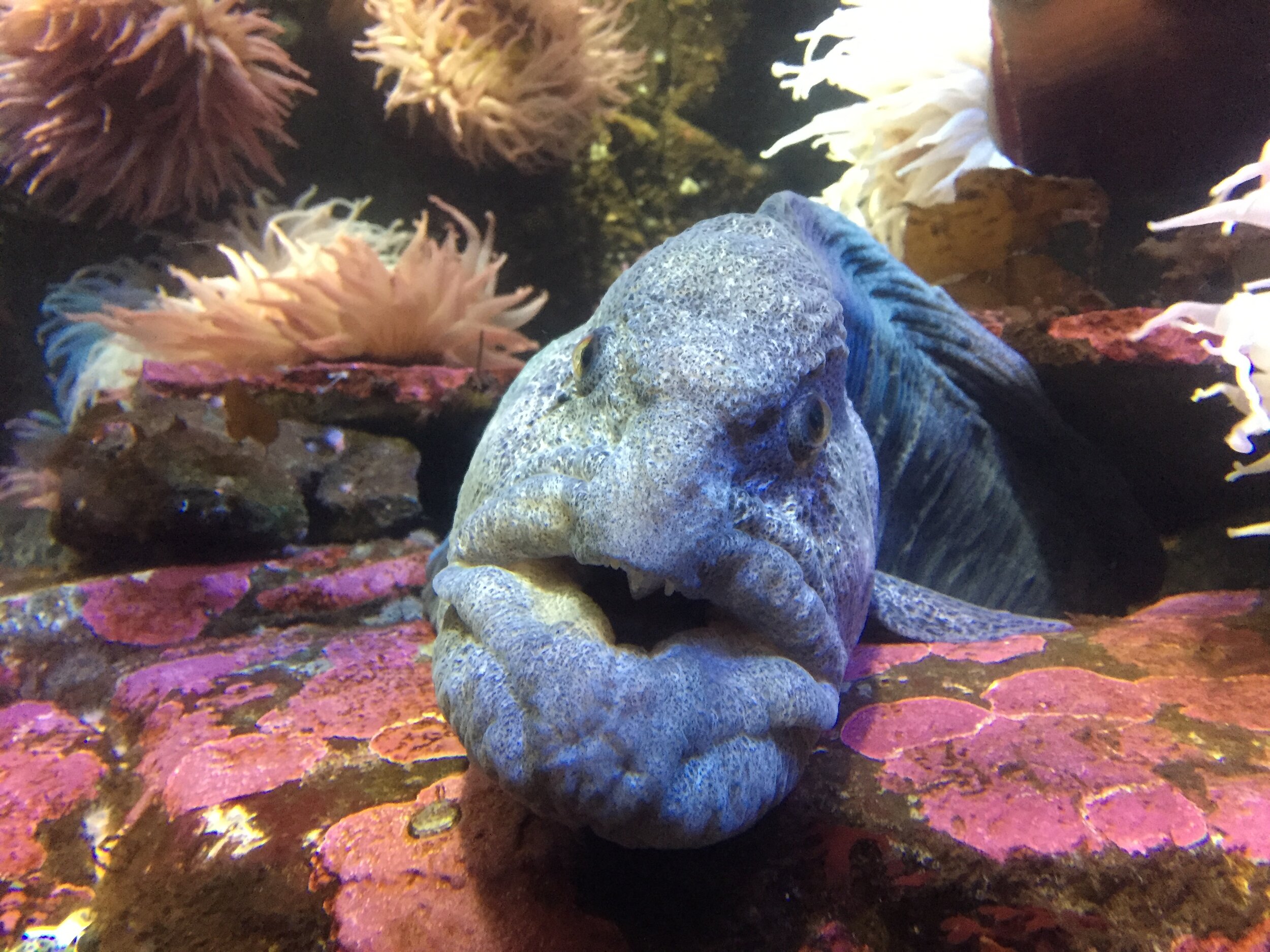Creature Features
Cool critters, fun facts, flashy pictures or an amazing video or two— we’re sharing a little bit about our animal residents!
KID-TRIBUTORS
Do you have a budding marine biologist at home? Perhaps you have some creative kids? Maybe they like to draw or write? Looking for something a little different to do from home? Create Salish Sea Creature Features.
Who: Kids 17 and under
What: Short (10 - 100 words) written account of a species or habitat and a related illustration or art piece
Why: Help others learn about species in the Salish Sea while practicing research, writing and art skills
How: Email to oceaneer1@salishseacentre.org and include first name, last name initial and age
When: Accepting submissions now
Harbour Seal, Alina C. (Age 11)
Harbour seals can dive 500 feet. During winter it’s blubber makes up 30 percent of its body mass. Harbour seals are found in the North Pacific and North Atlantic oceans. They eat Rockfish, Herring, Mackerel, Cod, Flounder and salmon. Wild harbour seals can live between 25-30 years or more in human care.
Crab & Anemone story, Miriam J. (Age 8)
Moon Jellies, Kathleen B. (Age 12)
“Or Aurelia aurita, the moon jellyfish is a common jellyfish of the Salish Sea. Their white colour, round shape, short tentacles really make them look like moons. These cute jellies usually travel in groups of large numbers. They do not eat fish or other jellies. Instead, they use their tiny tentacles to trap plankton and move it to their mouth in the center. They are very common around the world!”
Dolphins, Lucy H. (Age 8)
Dolphins of the Salish Sea
“Dolphins use echolocation to find their prey. Echolocation is when a dolphin makes a noise and bounces off the prey and comes back. This tells them how far away their prey is. Dolphins have one blowhole. They use it to breath.”
Pacific Sea Nettle, Hanna I. (AGE 6)
Salmon, Chase C. (Age 13)
How long is the lifespan of salmon: The average salmon lifespan is 3 to 8 years.
What do salmon eat: Young salmon feast on insects, invertebrates and plankton. While adult salmon feast on other fish, squid, eels and shrimp. but the sockeye salmon’s diet consists mostly of plankton.
What is the habitat of the salmon: The young salmon spawn and feed in freshwater, lakes, rivers and streams. While the adult salmon move out into the ocean and go back to freshwater areas to reproduce.
What is a male salmon called: A male salmon is called a boar.
What is a female salmon called: A female salmon is called a hen.
Orcas, Gaege G. (AGE 10)
My animal is an orca. It is a mammal.
Its habitat is an ocean.
It looks like a huge fish covered with black and white spots.
It moves by swimming.
Some interesting facts about this animal are: orcas are the most widespread mammal besides humans.
I chose this animal because 1) it lives in the Salish Sea 2) I like orcas
Sea Otter, Nova R. (age 12)
Sea Otters are very playful social marine mammals. Sea Otters are very unique. They are one of the only marine mammals that use tools. These otters use rocks to crack open the shells of their prey. Some otters even carry a favorite rock everywhere. Others will hide a rock and come back for it when they need it. Sea Otters lounge in kelp forests wrapped in the kelp, so they do not float away. Sometimes they hold paws to stay together. Sea Otters eat sea urchins, many types of shellfish, and once in a while they will catch a fish.
Green Sea Urchin, EVAN W. (AGE 5)
Green sea urchins decorate themselves to camouflage and protect themselves from sun at low tide.
This Fish Sucks! — Northern Clingfish
It’s clear where the Northern clingfish (Gobiesox maeandricus) got its name. Look at that large suction cup-like appendage on its belly. Pelvic and pectoral fins fused together and created a sucker disc that helps the fish cling tightly to rocks or blades of kelp and survive currents and wave action.
Northern clingfish are commonly encountered during intertidal explorations in the Pacific Northwest. A flattened head and tapering body allow the clingfish to nestle underneath, and in between, rocks, while the gray, brown, or dark red reticulated or chain-like pattern on their body help them camouflage.
It’s a hard rock life
Intertidal life is tough, not just wave action and hot sun but they are exposed to additional predators from the land. Mink, raccoons, gulls, and garter snakes will all devour a clingfish if given the chance.
A clingfish’s palate is keen on molluscs, worms, small crabs and other crustaceans. Have you experienced the tight hold limpets and chitons have onto rocks? It’s no match for a clingfish; using its sucker disc for stabilization and its chisel-like teeth it pries these prey off in a snap.
Get a griP
The sucker disc is a marvel. A traditional suction cup works well on dry, smooth surfaces but incredibly the Northern clingfish’s sucker adheres to wet, slimy and rough surfaces, and can hold up to 230 times its own body weight.
How does it work? The sucker disc is covered in layers of micro-sized (and various sized) hair-like structures. The soft hairs provide friction preventing movement in the edges of the suction cup and allow the fish to hold on to rough, uneven surfaces.
Scientists at the University of Washington are mimicking the clingfish’s design for new suction cup prototypes. The research can be applied across many industries, from tagging whales to the simple shower caddy.
Cool!
Wolf Eel Feels!
A wolf?
Wolf eels (Anarrhichthys ocellatus) with their large heads and menacing faces can earn a bad reputation. Turns out, they are anything but! These fish are actually quite slow moving, fairly sedentary, and known to be quite friendly and curious with divers. Individual wolf eels can even be identified by the dark spots on their heads and body, much like giraffes.
Adult male wolf eel in his rocky den
That menacing face mentioned earlier is a feature of the wolf fish family (Anarhichadidae); the ferocious appearance comes from the sharp teeth sticking out of their mouths. Their strong jaw, sharp teeth and THREE sets of molars (one in the middle of the roof of their mouth!) act like a nut-cracker to crunch and munch their favourite hard-shelled prey — sea urchins and crabs. Sea urchin spines are no match for a wolf eel.
Not an eel?
With long slender bodies, a wolf eel can easily be mistaken for a true eel. But look at their pectoral (front) fins; they’re absent in most “true” eels. The eel in their name is certainly misleading. Long thin bodies help wolf eels slither into rocky crevices and dens; their home of choice. Wolf eels can reach 2.4 m in length — that’s longer than a human!
Till death do us part…
Juvenile wolf eel
Rocky dens get pretty cozy with two wolf eels inside. Wolf eels form long lasting bonds or even mate for life during their 25 year lifespan. At 4 years old, wolf eels find a mate and settle down in a rocky den — honeymoon time! At 7 years old, they begin to reproduce. As diligent parents, they take turns protecting and aerating their egg cluster (7,000 - 10,000 eggs!) with their bodies. After 13 - 16 weeks incubation, 3.5 cm wolf eels emerge from the eggs. Juvenile wolf eels are bright orange in colour and swim throughout the water column looking for food before, at the age of 2 years old, they settle down into a more sedentary lifestyle.
Cool Crab!
Check out the spotted belly that gives the lovely spot-bellied rock crab (Cancer antennarius) its name! This crab is often hiding in sand or gravel or under large rocks but look for its reddish coloured spots and large black tipped claws.
It’s a boy! It’s a girl! How do you know? Look at its abdomen. Male crabs have a tall, narrow lighthouse-shaped abdomen compared to the female’s larger, rounder beehive-shaped abdomen.
http://www.pac.dfo-mpo.gc.ca/fm-gp/rec/crab-crabe-eng.html
Females have the extra room in their abdomen for good reason; this is where she will carry and care for her eggs. Using her pleopods she will first ventilate her abdomen to help form a basket to safely hold her eggs (see video below!). After successfully protecting her eggs, they hatch out as larvae and become part of the plankton soup drifting through the ocean.
Larvae undergo many molts before becoming the traditional crab shape we recognize. And in order to grow they continue to molt throughout their lifetime.
Knowing if a crab is female or male is very important if you’re crabbing for Dungeness crabs or red rock crabs. Female crabs are thrown back while male crabs can be measured and if their carapace (body without legs) meets the minimum allowable size, they’re keepers. This ensures, females and under-sized crabs can continue to grow and reproduce. Yay for sustainability!















